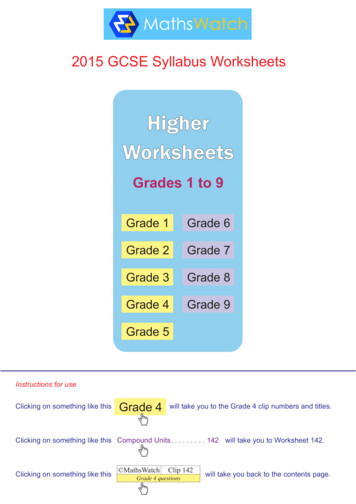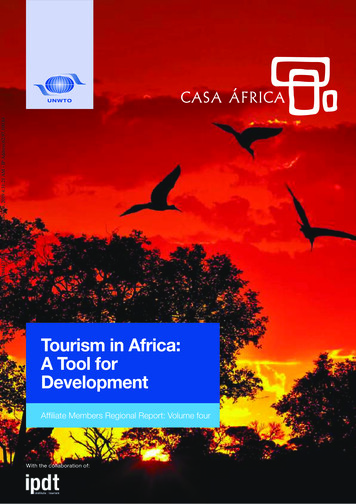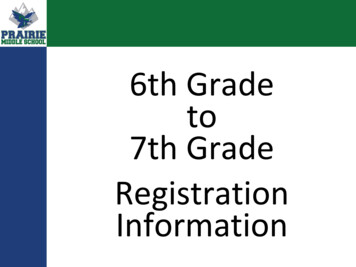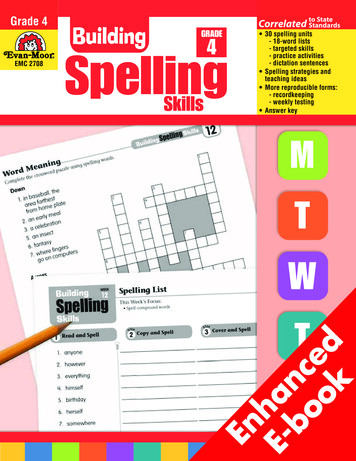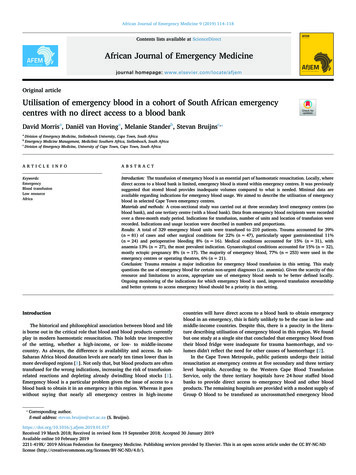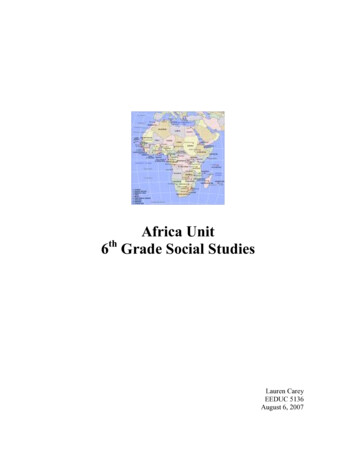
Transcription
Africa Unit6th Grade Social StudiesLauren CareyEEDUC 5136August 6, 2007
Table of ContentsI.OverviewII.Research Summary – Teaching Geography – Beyond the MapIII.Lessonsa. Initial Lesson – Where in the world is Africa?b. Inspiration Lesson - What makes one part of Africa different from anotherpart?c. Cross Circular Lesson - Live from Africa – Weather forecast based onclimate and ecosystemd. Primary Source Lesson - People and Cultures of Africae. Final Lesson - Using the Newspaper to Locate AfricaIV.Website Review – NationalGeographic.comV.Evaluation – Day in the Life Journal EntryVI.Annoted Bibliography2
OverviewThe unit was designed for a sixth grade class with the intention on teachingstudents about the physical and cultural geography of Africa. The lesson were based onthe standards in the Massachusetts History and Social Science Curriculum Frameworksfor sixth grade classrooms. The lessons address history and geography standards that aregeneral (identifying how atlases are organized) as well as standards that are specific tothe continent of Africa, such as locating the continent on a world map and recognizingcountries and major cities of Africa.Another factor in this unit selection was to promote personal learning of thecontinent. I barely recall any learning in my prior education on the continent. I wantedto learn not only about the physical landmarks of Africa, but also about the people ofAfrica. I feel like in our technologically connected world, we should learn about thevarious people that occupy our planet.The Africa unit is an attempt to dispel myths of Africa that are perpetuated intextbooks and through the media. Throughout the unit, students will learn that Africa is acontinent representing many countries and cultures. Students will learn the people ofAfrica embody many different cultures. Students will also learn that Africa does notconsist solely of villages, Africa has major cities. Students will walk away from theselesson with a greater understanding for the similarities and differences of Africa, not onlythe people, but also the physical geography of the continent.3
Research SummaryTeaching Geography – Beyond the MapWhen some people think of geography, they may recall a class in which theylooked at a map and located states or nations on maps. They may have learned ofgeographical terminology and learned the capitals of states or countries. The idea ofgeography needs to be expanded as we are living in an increasingly connected globalsphere. Students need to study geography to dispel stereotypes, gain knowledge ofdifferent cultures, and examine and scrutinize current events. How can we expect thestudents of today to become leaders of tomorrow without an understanding of the worldthat they live in?Carano and Berson (2007) write that several studies have shown that youths andyoung adults in the United States are lacking geographical wisdom. The deficiency ofgeographical knowledge can be seen is stark when compared to the awareness of peersfrom other industrialized nations from across the globe. Some American students areunable to locate countries such as Brazil or Iraq on a world map.Not only are students unable to locate where certain countries are on a map, theyare also susceptible to stereotypes that are portrayed in the media. It is important to notethat some stereotypes are perpetuated in classroom textbooks; these textbooks may showa distorted view of foreign cultures. An important part of education, especially in thecase of social studies, is learning how to sort through bias in the media and textbooks.Several suggestions are offered to aid students in geography scholarship. Caranoand Berson (2007) suggest using technology in the classroom to breakdown some of thebarriers in this discipline. They suggest that Internet offers interconnectivity to otherstudents across the globe. Through this strategy, learners can share their thoughts andideas with other learners. The website http://www.epals.com/?id siteLogo, offersstudents and teachers the opportunity to communicate with students across the globe.Another suggestion is to use new web sites to allow students to be cognizant ofworld events. This allows students to see what events are occupying the headlines andthoughts of the countries that they are studying. It would be valuable for students to4
compare and contrast foreign headlines with those of the world headlines that arepublished in the United States.A third technological initiative is to use map sites such as Google Maps tobecome aware of the world’s physical makeup. Through map sites such as Google,students are granted virtual access to new environments that are thousands of miles awayfrom their homes and classrooms. Students can explore terrain that they may never get toexperience first hand.Another suggestion to enhance pupils’ global awareness is to immerse them in acurrent “hot topic”. Sweeney (1997) captures the essence of a project done with fourthgrade students on the subject of the South African apartheid and elections of the mid1990’s. The students were exposed to documentaries, photographs, literature, and newsheadlines about the apartheid. The students connected this period with that of theAmerican Civil Rights movement.These learners participated in a multi-disciplinary study of South Africa. Theirexposure to South Africa had connections to math, reading, writing, music, and art. Thestudents also taught their new knowledge to their peers at the school through a play thatwas to be performed to other students at the school in grades three through five. Notonly did this experience expose the students to another culture and geography, theybecame experts in the subject and were able to teach their peers.Geography is not a subject that is just limited to maps and technical terms. It is asubject that exposes learners to world events. Through the study of geography, studentscan become citizens of the world by learning about other people is distant lands. Thisallows students to be empathetic to plights of people who are not as fortunate as they are.It also rejects myths that students may have of citizens of other countries. Students in theUnited States may discover that their interests may mirror those of their peers in foreigncountries. The comprehensive study of geography exposes the commonalities that existbetween all people of the planet.5
Lesson Plans6
Where in the world is Africa?Africa Unit – Initial Lesson Plan – Sixth GradePurpose:Based on the Massachusetts State Frameworks, students have worked on map and globeskills in their elementary school education. In this lesson students will extend theirknowledge of geographic terms and apply them to the continent of Africa.Objectives: Students will locate the continent of Africa on a world map. Students will demonstrate an understanding that Africa is comprised of over fiftycountries. Students will label the African countries and their capitals. Students will distinguish the major regions of the continent. Students will name significant geographical features of Africa.Connection to the MA State History and Social Science Frameworks (Sixth Grade):5. Identify how current world atlases are organized and the kind of information theyprovide for each continent and country.A.1 On a map of the world, locate the continent of Africa, the Atlantic Ocean, the IndianOcean, the Mediterranean Sea, and the Great Rift Valley. On a map of Africa, locate thenorthern, eastern, western, central, and southern regions of Africa, the Sahara Desert, theNile River, Lake Victoria, Mount Kilimanjaro, and the Cape of Good Hope.A.2 Use a map key to locate the countries and major cities in Africa.Materials:Africa is Not a Country, by Margy Burns KnightWorld map large enough for entire class to seeWorld map handouts for each studentAfrica map copies for each student (countries labeled by number)7
Corresponding numbered sheet for labeling countriesOne atlas per four studentsPencilsColored pencils, crayons, or markersSocial studies folderLabeled African map for student assessmentProcedures:Activating Activity: Read Africa is Not a Country aloud to the class.Core Procedures:1. Ask the class what they know about Africa (this can be country names, geographicregions, major geographical landmarks, or notable Africans).2. Distribute world maps to each student.3. Ask a student volunteer to identify Africa on the large class map.4. Instruct the class to locate Africa after they see their peer identify it on the classroommap.5. Ask a students how big Africa is in comparison to the rest of the continents.6.Discuss the size of the continent.7. Ask and then discuss how many countries Africa consists of.8. Distribute blank maps of Africa to each student.9. Assign students to six pre-determined groups.10. Distribute atlas to each group.11. Distribute crayons, colored pencils, and markers to the class.12. Students will use atlases to identify African countries and label them on their maps.13. Students will be instructed to also name and label each nations capital on the map.14. Students will color each country and will be instructed to make sure that eachadjacent country is not the same color.15. After completing the exercise, students (in their groups) will show the teacher theirAfrica maps.16. Students will file the completed maps in their social studies folder.8
Closing Procedure: Students will be assigned different groups for the next day’s lesson.There will be five groups to study the northern, eastern, western, middle, and southernregions.Assessment:The teacher will look over each student’s map in comparison to the master copy to ensurethat all countries were identified correctly.Modifications: Students with ADHD can be assigned the role of materials distributors. The map of Africa will be labeled by number and a separate sheet of paper withthose numbers will be available for students to label the smaller land-lockedcountries. Students will be asked to identify twenty-five of the countries instead of all fiftythree African countries.Extensions:Students can write down questions that they would like answers to about Africa.9
11
12
Lesson Plan las/africa/africa-bw.pdf. Retrieved July 16, 2007This link is an unlabeled map of las/africa/africa-dw.pdf. Retrieved July 16, 2007.This link is a labeled map of Africa which identifies each tlas/world/world-d.pdf. Retrieved July 16, 2007This link provides a blank world map.Knight, M.B. (2001). Africa is not a country. Brookfield, CT: Millbrook Press
What makes one part of Africa different from another part?Africa Unit - Inspiration Lesson Plan – Sixth GradePurpose:In this lesson, students will work cooperatively in groups to study the different regions of Africa. Theirstudy will include understanding the countries that exist in the region, the climate, wildlife, major physicalcharacteristics, and major natural resources. This lesson will be a jigsaw lesson, as different groups willpresent their newly acquired knowledge to the rest of the class.Objectives: Students will work cooperatively in groups to research their given region of Africa. Students will present their findings to the class. Students will use different research sources such as the Internet, textbook, and atlas to fill in theirgraphic organizers. Students will expand on critical thinking skills to examine settlement and economies of Africancountries based on climate, physical characteristics, natural resources, and population size. Students will demonstrate ability to use the Internet as a classroom resourceConnection to the MA State History and Social Science Frameworks (Sixth Grade):A.3 Explain how the following five factors have influenced settlement and the economies of major Africancountries and regions. (G, E)A. absoulte and relative locationsB. climateC. major physical characteristicsD. major natural resourcesE. population sizeMaterials:Regions of Inspiration created Africa graphic organizers (multiple copies for each student)One atlas per four studentsPencils and pens14
Social studies folderComputers with Internet accessProcedures:Activating Activity: In a class brainstorm, students will discuss what necessities to life are essential withincommunities.Core Procedures:1. The students will be given a picture of the regions in Africa and will need to list the countries.2. The class students will get into their groups to start studying their pre-assigned region of Africa.3. The blank graphic organizers will be distributed.4. The atlases will be distributed.5. Students will be instructed to find pictures to aid their presentations.6. The students can choose to use their textbook, atlas, or the computer to help them look up theinformation that is on their graphic organizer.7. While in their groups, the students can determine if they should split up the categories or if theyshould work as a team to fill in the information on their organizer.8. Students will fill in information on their graphic organizer. If necessary, students can use additionalorganizers to fill in information.Closing Procedure: In groups, students will share and present their findings on their assigned regions to theclass. All students will be given additional blank graphic organizers to fill in the information that ispresented.Assessment:Students will be evaluated on how well they work in a group. Each group member will be expected topresent at least one fact that they learned as part of their research.Modifications: Students will be assigned roles in their groups such as Materials Getter (gets all group materials),Timekeeper (keeps an eye on the clock to make sure that the group is on task), Personnel Manager15
(group leader determines if the group will work together or individually to fill out their organizer),and Reporter(s) (will present the group’s findings).Extensions:If some groups finish before the rest of the class, they can choose a book about Africa (fiction or nonfiction) to read quietly.16
Inspiration Maps17
EasternRegion ofAfricaMajorNaturalResources123Major PhysicalCharacteristics123ClimateCountries &PopulationSizes123Wildlife1231234567891011
MiddleRegion ofAfricaMajorNaturalResources123Major PhysicalCharacteristics123ClimateCountries &PopulationSizes123Wildlife1231234567891011
NorthernRegion ofAfricaMajorNaturalResources123Major PhysicalCharacteristics123ClimateCountries &PopulationSizes123Wildlife1231234567891011
SouthernRegion ofAfricaMajorNaturalResources123Major PhysicalCharacteristics123ClimateCountries &PopulationSizes123Wildlife1231234567891011
WesternRegion ofAfricaMajorNaturalResources123Major PhysicalCharacteristics123ClimateCountries &PopulationSizes123Wildlife1231234567891011
Lesson Plan SourcesBrock, B.J. & LeVasseur, M. (2006). Africa contemporary issues content guide for educators. In NationalGeographic Education and Children’s Programs. Retrieved July 23, 2007, uides/contempafricaguide.pdfThis document provided a map used in the Inspiration graphic organizers.Inspiration (Version 8) [Computer software]. Beaverton, OR: Inspiration Software Inc.This software was used to create the graphic organizers used in the lesson.18
Live from Africa – Weather forecast based on climate and ecosystemCross Circular Lesson Plan – Africa Unit – Sixth GradePurposeThe students have studied the various regions of Africa and have identified the climate, natural resources,major physical landmarks, wildlife, and countries. In this lesson, the students will tie in their scienceknowledge with geographic knowledge to examine the impact of climate in their given region. The studentgroups will present their findings to the entire class in the form of a weather forecast.Objectives The students will examine the ways how climate and land forms affect African ways of life. The students will explore pre-assigned regions of Africa and the major physical features such as theNamib Desert and the Nile River Valley. The students will discuss the features of Africa’s landscape. The students will classify climates of Africa.Connection to MS State History and Social Science Frameworks (Sixth Grade) MA.1. - Concepts and Skills: History and Geography: Explain the difference between absolute andrelative location and give examples of different ways to indicate relative location for countries orcities across the world. (G) MA 6.4. - Concepts and Skills: History and Geography: Explain the difference between absolute andrelative location and give examples of different ways to indicate relative location for countries orcities across the world. (G)Connection to MA Science and Technology/Engineering Curriculum Framework (Sixth Grade) MA.2. - Living Things and Their Environment: Give examples of ways in which organisms interactand have different functions within an ecosystem that enable the ecosystem to survive. MA 2.13. - Living Things and Their Environment: Give examples of ways in which organismsinteract and have different functions within an ecosystem that enable the ecosystem to survive. MA 2.17. - Changes in Ecosystems Over Time: Identify ways in which ecosystems have changedthroughout geologic time in response to physical conditions, interactions among organisms, and the19
actions of humans. Describe how changes may be catastrophes such as volcanic eruptions or icestorms.MaterialsComputer with projectorNotebooksPens/PencilsLarge Map of AfricaPre-cut weather symbols, such as a sun, clouds, monsoon, etc List of student African region groupsProcedures:Activating ActivityUsing the computer and the projector, play Africa: Land and Resources video from United etDetail.cfm?guidAssetID ccaa50f1-11ee-4c3e-89a2413083e3bae1Core Procedures1. The teacher informs the students that they are going to create a weather forecast for their region ofAfrica.2. The students will get into their Regions of Africa Group (they worked in these groups when theywere gathering data on the regions of Africa).3. The students, in their groups, decide who will be the meteorologist, the forecast writers, the mapdirector, and the producer of their weather segment.4. The students will discuss the climate(s) in their regions.5. The students will work together to research what types of weather are applicable to the climate(s).6. The forecast writers will write the broadcast. The producer will work with the meteorologist and mapdirector to decide how they will present their broadcast.7. Students will write and print their forecast.8. The “gopher” student will make copies of their groups forecast for each student in class.20
Closing ProceduresStudents will present their weather forecast to the class.AssessmentStudents will be graded against the rubric. Students will be assessed on working collaboratively in a group.Students must define the climate and ecosystem for the class.ModificationsThere are various roles a student can have within their groups.The map will be large so that all students can see it.Groups will distribute a printed forecast to students with auditory difficulties.ExtensionsIf students finish early, they can fill in a Word Search on regions and countries in Africa.21
Lesson Plan SourcesAfrica: Land and Resources. AIMS Multimedia(2001). Retrieved July 31, 2007, from s is a video about Africa’s land and resources. The video is 18 minutes long. A teacher’s guideis also within this link. The guide includes instructions on how to use the video and includessuggestions for after the video. The guide also includes an introduction to the vocabulary.22
People and Cultures of AfricaAfrica Unit – Primary Source Lesson Plan – Sixth GradePurposeBefore this lesson, the students discovered and explored Africa. At this point, they are able to name thecountries in Africa and studied the major regions of Africa. They have examined the physical aspects of themajor regions of the continent (absolute and relative locations, climate, wildlife, major physicalcharacteristics, major natural resources, and population sizes). It is now time for the students to study andbe introduced to the people and cultures of Africa. This will be a four-day lesson and project. The studentshave also had a mini-lesson on what constitutes a primary source.Objectives Students will navigate the Internet to find reliable primary sources. Students will discern primary sources from secondary sources. Students will examine the people and cultures of the major regions of Africa. Students will utilize and demonstrate proficiency in using PowerPoint. Students will compile cultural information to be presented in PowerPoint. Students will present their learnings and teach the class.Connection to the MA State History and Social Science Frameworks (Sixth Grade):A.2 Use a map key to locate countries and major cities in Africa.Optional topics for study:Describe the major ethnic and religious groups in selected countries in Africa.Describe the general level of education in selected countries in Africa and its relationship to the economy.Describe the political and social status of women in selected countries in Africa.MaterialsJournal entry written by Richard Lipinski Jr.Pictures of village in TanzaniaPictures of Nairobi, KenyaUseful website listCountry names on separate pieces of paperEmpty bag or hat23
Computer LabComputers with Internet access for each studentPowerPointRed plastic cupsRubricComputer projectorProceduresActivating Activity –. The teacher will read the journal entry written by Richard Lupinski Jr. about life in asmall African village.Core Procedures1. The teacher will ask students if they think that all Africans live in small villages such as the onedescribed in the journal entry.2. The teacher will show the class the picture of the city of Nairobi.3. The teacher will inform the class that they are going to learn about the various cultures and people inAfrica.4. The class will discuss what the definition of culture is.5. The teacher will tell the class that they will teach their peers about various African cultures througha PowerPoint presentation.6. The teacher will walk around the classroom with a bag containing the names of pre-selected Africannations.7. Each student will select one country name to study.8. The students will be given the presentation rubric so that they are aware of which items they mustinclude in their presentation.9. Students will be told that they can add extra items about the culture and people of their nation.10. Students will be given a list of helpful websites for their project.11. The class will discuss the difference between a primary and secondary source (this is an item ontheir rubric).12. The class will get in line to go to the computer lab.13. The class will walk to the computer lab.14. Computers will be turned on for students to start working immediately.15. Students will be given two full class periods to research their country.Day Three24
1. Students will be given one class period to put their PowerPoint presentation together.2. During Writer’s Workshop, students will share their presentation for peer editing with one classmate(groups are pre-selected).Day Four1. The final class period for this lesson will be devoted to sharing the presentations.Closing ProceduresStudents will present their findings to the class.AssessmentPresentations will be graded based upon a rubric.Modifications Website lists are distributed to aid all students in their search, especially those with organizationalissues. The website list will also be posted on the class website so that students can simply click onthe links in the document. Red plastic cups will be next to each computer. If a student faces a roadblock he or she will place iton top of the computer monitor indicating that they will need some help. Groups are pre-selected during peer-editing so that stronger writers are paired with students whosewriting skills are still developing.ExtensionsIf students are finished early with peer editing, they can go to the music station in the classroom to listen toAfrican music. Students also have the option to read books about Africa.25
Useful limate of countries.htmlCOUNTRY com/flags/GENERAL AFRICA armafrica.com/GENERAL GEOGRAPHY edu/ jmaxim/web geography for w.historyforkids.org/learn/africa/environment/KID SEARCH p.htm (this one is interactive)26
/www.ncbuy.com/travel/health/report country.html?code es d/index.html (kids in Africa)PICTUREShttp://images.google.com/imghp?hl en&tab wiTEACHER www.southafrica-travel.net/pages/e plants.htmWEBQUESThttp://members.tripod.com/africa cms des/Wildlife/Vertebrates/Mammals/Big 5/Big 5 of Southern t.htm27
Nairobi, KenyaVillage in Tanzania28
African Countries(List to be cut up prior to lesson for student drawing)AlgeriaAngolaBotswanaCameroonCentral African RepublicChadDemocratic Republic of the CongoEgyptEthiopiaKenyaIvory gerNigeriaSouth AfricaSudanRwandaTanzaniaTunisiaZambiaZimbabwe29
African Culture Rubric30
African Culture RubricExcellentProficientSatisfactoryNeeds WorkResearch10 pointsMade excellent useof computer time andfound several extranon-required items.Cited sources.Made good use ofcomputer time andfound a few nonrequired items.Cited sources.Made ample use ofcomputer time. Metminimum number ofrequired items.Cited sources.Not focused onresearch duringcomputer time.No cited sources.RequiredComponents10 pointsLabeled country mapwith capital, majorcities and majornatural physicalcharacteristics.Picture of capital city.Pictures of people.List of commonreligions.List of commonlyspoke languages.List of tribes.Pictures of homes.Pictures of art.Examples ofliterature.Type of industry (ex.Agricultural,Manufacturing,Mining)Labeled countrymap with capital,major cities andmajor naturalphysicalcharacteristics.Picture of capitalcity.Pictures of people.List of commonreligions.List of commonlyspoke languages.List of tribes.Pictures of homes.Country map labeledwith capital city andeither major cities ornatural physicalcharacteristics.Picture of capital city.Pictures of people.List of commonreligions.List of commonlyspoke languages.List of tribes.No map or pictures.No list of culturalitems (religion,language, homes,tribes)
African Culture RubricExcellentProficientSatisfactoryNeeds WorkContent10 pointsThe text is written withno errors in grammar,capitalization,punctuation, andspelling.The text is written withno errors in grammar,capitalization,punctuation, andspelling.The text is written withno errors in grammar,capitalization,punctuation, andspelling.The text is written withno errors in grammar,capitalization,punctuation, andspelling.PowerPoint5 pointsThe fonts are easy-toread and point sizevaries appropriately forheadings and text.Use of italics, bold, andindentations enhancesreadability.Text is appropriate inlength for the targetaudience .Creative use of colorsand background.The layout is visuallypleasing andcontributes to theoverall message withappropriate use ofheadings, subheadingsand white space.Sometimes the fontsare easy-to-read, butin a few places the useof fonts, italics, bold,long paragraphs, coloror busy backgrounddetracts and does notenhance readability.The layout useshorizontal and verticalwhite spaceappropriately.Sometimes the fontsare easy-to-read, butin a few places the useof fonts, italics, bold,long paragraphs, coloror busy backgrounddetracts and does notenhance readability.The layout showssome structure, butappears cluttered andbusy or distracting withlarge gaps of whitespace or uses adistractingbackground.Sometimes the fontsare easy-to-read, butin a few places the useof fonts, italics, bold,long paragraphs, coloror busy backgrounddetracts and does notenhance readability.The layout is cluttered,confusing, and doesnot use spacing,headings andsubheadings toenhance thereadability.
African Culture RubricExcellentOralPresentation5 pointsPoised, cleararticulation; propervolume; steady rate;good posture and eyecontact; enthusiasm;confidence.Held attention ofaudience throughoutpresentation.ProficientClear articulation butnot as polished.Held audience’sattention most of thetime.SatisfactorySome mumbling; littleeye contact; unevenrate; little or noexpression.Held audience’sattention most of thetime.Needs WorkInaudible or too loud;no eye contact; ratetoo slow/fast; speakerseemed uninterestedand used monotone.Did not captureaudience attention.
Lesson Plan Sourceshttp://members.tripod.com/africa cms cwr/index.htm. Retrieved on July 26, 2007.This is WebQuest that has several informative links about various aspects of Africa.http://images.google.com/imgres?imgurl http://www.theodora.com/wfb/photo
Social studies folder Labeled African map for student assessment Procedures: Activating Activity: Read Africa is Not a Country aloud to the class. Core Procedures: 1. Ask the class what they know about Africa (this can be country names, geographic regions, major geographical landmarks, o


